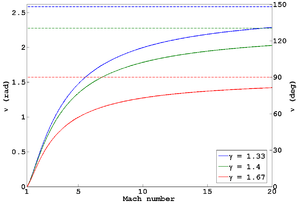Prandtl–Meyer function
In aerodynamics, the Prandtl–Meyer function describes the angle through which a flow turns isentropically from sonic velocity (M=1) to a Mach (M) number greater than 1. The maximum angle through which a sonic (M = 1) flow can be turned around a convex corner is calculated for M = . For an ideal gas, it is expressed as follows,

where is the Prandtl–Meyer function, is the Mach number of the flow and is the ratio of the specific heat capacities.
By convention, the constant of integration is selected such that
As Mach number varies from 1 to , takes values from 0 to , where
| For isentropic expansion, | |
| For isentropic compression, | |
where, is the absolute value of the angle through which the flow turns, is the flow Mach number and the suffixes "1" and "2" denote the initial and final conditions respectively.
See also
- Gas dynamics
- Prandtl–Meyer expansion fan
References
- Liepmann, Hans W.; Roshko, A. (2001) [1957]. Elements of Gasdynamics. Dover Publications. ISBN 978-0-486-41963-3.